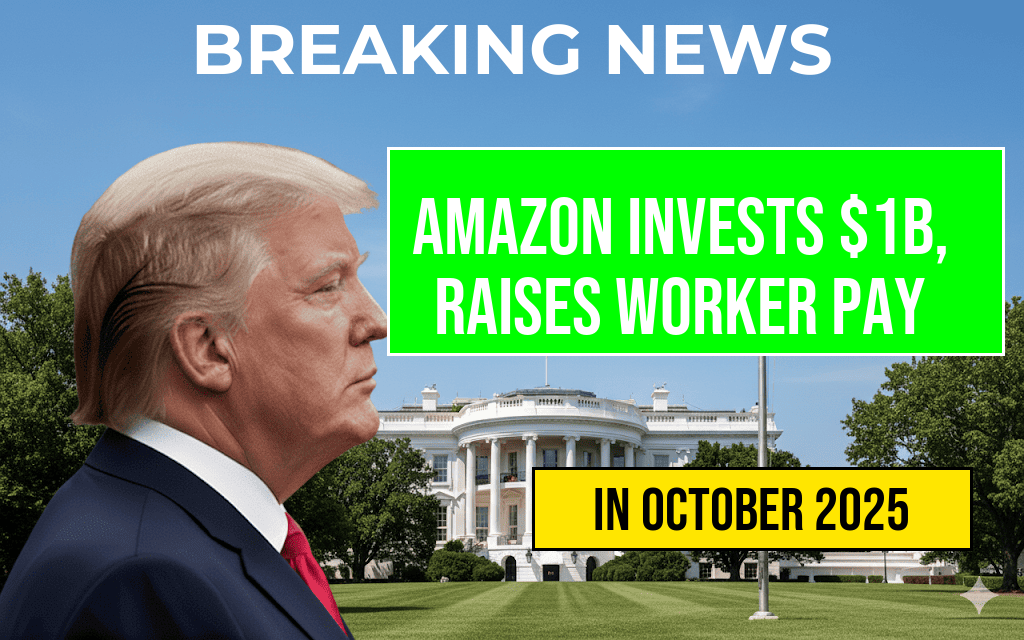Amazon has announced a $1 billion investment aimed at enhancing its fulfillment operations, a move that has directly increased the average hourly pay for its warehouse workers to over $23 per hour. This substantial financial commitment, part of the company’s ongoing efforts to improve worker compensation and working conditions, marks a significant shift in its approach to employee wages. The investment, which spans multiple facilities across the United States, is also expected to bolster job security and operational efficiency amid a competitive logistics landscape. As Amazon continues to expand its global footprint, this wage increase underscores its response to industry pressures, workforce demands, and a broader push for better labor standards in the e-commerce sector.
Details of the Investment and Pay Increase
Scope and Distribution of the $1 Billion Commitment
- The investment covers upgrades to fulfillment centers, technology infrastructure, and worker amenities.
- Funds are allocated across more than 100 facilities nationwide, including major distribution hubs in states like Ohio, Texas, and California.
- Additional resources are directed toward training programs and safety initiatives to improve employee retention and well-being.
Impact on Worker Compensation
| Period | Average Pay (USD per hour) |
|---|---|
| Pre-Investment | $19.50 |
| Post-Investment | $23.10 |
According to internal reports, the increase has elevated the average hourly wage for fulfillment workers to over $23 per hour, a notable rise from previous levels. This adjustment is part of Amazon’s broader strategy to attract and retain a skilled workforce amid a tightening labor market and increasing competition from other logistics providers.
Industry Context and Worker Response
Broader Trends in Warehouse Compensation
Amazon’s wage hike reflects a shifting landscape within the logistics and e-commerce industries. As companies grapple with labor shortages and heightened scrutiny over working conditions, many are revising compensation packages. The move aligns with industry analyses indicating that competitive wages are essential for maintaining operational stability and managing turnover rates.
Worker Perspectives and Unionization Efforts
Some worker advocacy groups have welcomed Amazon’s increased pay, viewing it as a positive step toward better labor standards. However, unionization efforts continue to challenge the company’s labor practices, with workers demanding not only higher wages but also improved safety measures and predictable schedules. While Amazon maintains that it prioritizes employee safety and satisfaction, critics argue that wage increases alone do not address deeper issues related to working conditions.
Economic and Strategic Implications
Impact on Amazon’s Operational Costs
While the $1 billion investment represents a significant capital expenditure, Amazon’s leadership believes that improved wages will ultimately lead to increased productivity and lower turnover costs. Higher pay can also serve to bolster morale and reduce absenteeism, translating into more reliable fulfillment operations.
Competitive Positioning
In an environment where logistics giants like FedEx and UPS are also raising wages, Amazon’s proactive investment demonstrates a strategic effort to stay ahead. By investing heavily in its workforce, Amazon aims to solidify its reputation as an employer of choice within the e-commerce sphere, which is crucial as it faces mounting pressure to sustain rapid growth.
Future Outlook
Industry analysts suggest that Amazon’s wage increases may set a precedent across the e-commerce sector, prompting other companies to follow suit. As the labor market remains tight, especially for warehouse and logistics roles, competitive compensation packages are expected to become standard practice. The company’s ongoing investments in worker welfare and infrastructure could also influence broader labor standards within the industry.
For more on Amazon’s business strategies and labor practices, see Wikipedia’s overview of Amazon and recent industry analyses on Forbes.
Frequently Asked Questions
What is the purpose of Amazon’s one billion dollar investment?
Amazon’s one billion dollar investment is aimed at enhancing its fulfillment workforce by increasing average pay and improving working conditions across its fulfillment centers.
How much has the average pay for fulfillment workers increased?
The average pay for fulfillment workers has risen to over twenty-three dollars per hour, reflecting Amazon’s commitment to better compensation for its employees.
When did Amazon announce this significant pay increase?
Amazon announced the pay raise and investment as part of its recent efforts to invest in its workforce, with the impact visible shortly after the announcement in their fulfillment centers.
What are the expected benefits of this investment for Amazon’s fulfillment workers?
This investment is expected to lead to higher wages, improved working conditions, and increased employee satisfaction within Amazon’s fulfillment centers.
Does this investment affect Amazon’s overall business strategy?
Yes, the one billion dollar investment aligns with Amazon’s strategic focus on employee retention and competitive compensation to maintain its market leadership and ensure efficient order fulfillment.






